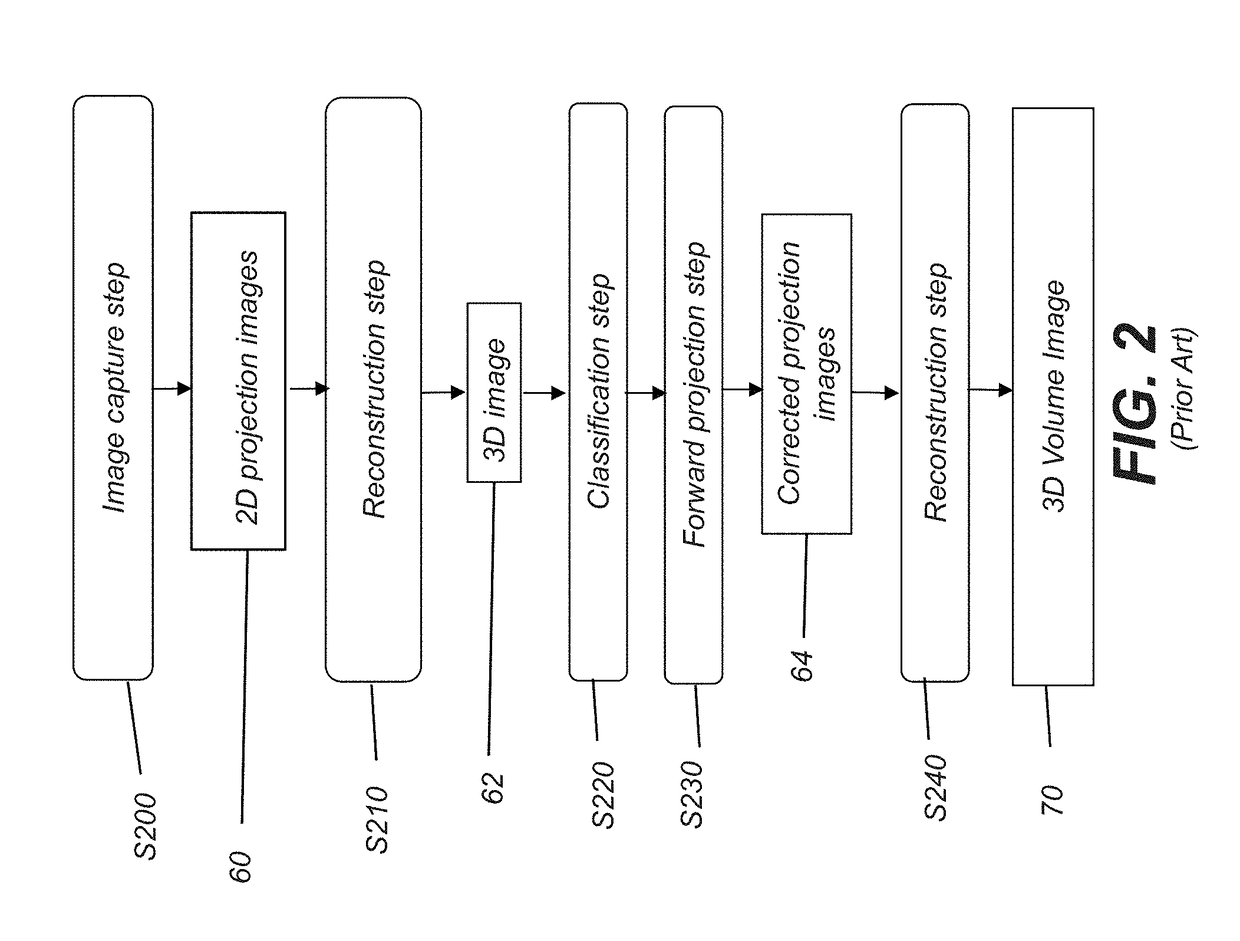Although 3D images of
diagnostic quality can be generated using CBCT systems and technology, a number of technical challenges remain.
Highly dense objects, such as metallic implants, prostheses and related appliances,
surgical clips and staples,
dental fillings, and the like can cause various image artifacts that can obscure useful information about the imaged features.
These artifacts, generically referred to as metallic artifacts or metal artifacts, can reduce
image quality by masking
soft tissue structures, not only in the immediate vicinity of the dense object, but also throughout the entire image.
Without some type of compensation, this can falsify CT values and even make it difficult or impossible to use the reconstructed image effectively in assessing patient condition or properly planning
radiation therapy or other treatments.
1. Interpolation-based FBP reconstruction approach. This approach operates in the projection domain, where the metal feature or shadow is identified and obscured values are interpolated using
nonmetal-contaminated neighbors. For some types of imaging, with a single metal object within a relatively homogeneous volume, this method works acceptably. However, in more complex heterogeneous tissue, particularly where there are multiple metal objects in a heterogeneous volume, the interpolation-based
algorithm can make unrealistic assumptions about the volume segment that lies in the shadow of the feature or object(s), leading to prominent errors in the reconstructed images. Theoretically, it is known in the 3D imaging arts that any interpolation-based repair scheme of the
Radon space is based on a weak underlying model. Hence, it cannot be expected that the estimated projection data will suitably fit the projection data if measured without metal objects.
2.
Iterative reconstruction approach. Generally improved over the performance of interpolation-based FBP described in approach (1), the
iterative reconstruction approach is also more successful for severely distorted images.
Iterative reconstruction uses some prior knowledge of the image
physics,
noise properties, and imaging geometry of the
system. For this method, it is necessary to have information about the shape and location and, possibly, the attenuation coefficients of the metal objects in the reconstruction
image domain. Typically, a constrained optimization approach is applied, which can be very sensitive to
system configurations and to the quality of the projection data. These requirements are easily met for
computer simulation or phantom imaging, and have been experimentally tested by researchers; however,
iterative reconstruction may be impractical for clinical use, where volume geometries are considerably more complex than those used in
simulation. Furthermore,
iterative reconstruction methods are computationally much more intensive than FBP, making these methods less practical for clinical use in commercial CT scanning apparatus.
3. Quasi-iterative based FBP approach. The quasi-iterative based FBP approach performs clustering in the reconstruction domain after the initial 3D image reconstruction, without any metal correction or with metal correction introduced in approach (1) (above). The
voxel elements of the reconstructed volume are classified into several tissues, such as
soft tissue, bone, air, etc., with each
voxel assigned a value corresponding to one of these tissue types. This method then forward projects the classified reconstruction volume onto each metal-affected
detector element and subsequently generates a final reconstruction of the thus modified
raw data to obtain the metal artifacts reduced volume. This method outperforms the interpolation-based FBP approach. The most prominent feature of this method is suppression of secondary artifacts caused by the interpolation scheme. However, one drawback of this method is that it fails whenever the interpolation based approach (1) fails. Moreover, quasi-iterative
processing cannot
handle the case where the object size exceeds the
field of view, since additional artifacts caused by the forward projection are introduced in the corrected images.
It is recognized that metal artifacts reduction is a challenging task, particularly where
implant geometries may be more complex.
 Login to View More
Login to View More  Login to View More
Login to View More 


